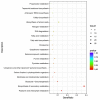The draft genome of Nitzschia closterium f. minutissima and transcriptome analysis reveals novel insights into diatom biosilicification
- PMID: 38840265
- PMCID: PMC11151724
- DOI: 10.1186/s12864-024-10479-9
The draft genome of Nitzschia closterium f. minutissima and transcriptome analysis reveals novel insights into diatom biosilicification
Abstract
Background: Nitzschia closterium f. minutissima is a commonly available diatom that plays important roles in marine aquaculture. It was originally classified as Nitzschia (Bacillariaceae, Bacillariophyta) but is currently regarded as a heterotypic synonym of Phaeodactylum tricornutum. The aim of this study was to obtain the draft genome of the marine microalga N. closterium f. minutissima to understand its phylogenetic placement and evolutionary specialization. Given that the ornate hierarchical silicified cell walls (frustules) of diatoms have immense applications in nanotechnology for biomedical fields, biosensors and optoelectric devices, transcriptomic data were generated by using reference genome-based read mapping to identify significantly differentially expressed genes and elucidate the molecular processes involved in diatom biosilicification.
Results: In this study, we generated 13.81 Gb of pass reads from the PromethION sequencer. The draft genome of N. closterium f. minutissima has a total length of 29.28 Mb, and contains 28 contigs with an N50 value of 1.23 Mb. The GC content was 48.55%, and approximately 18.36% of the genome assembly contained repeat sequences. Gene annotation revealed 9,132 protein-coding genes. The results of comparative genomic analysis showed that N. closterium f. minutissima was clustered as a sister lineage of Phaeodactylum tricornutum and the divergence time between them was estimated to be approximately 17.2 million years ago (Mya). CAFF analysis demonstrated that 220 gene families that significantly changed were unique to N. closterium f. minutissima and that 154 were specific to P. tricornutum, moreover, only 26 gene families overlapped between these two species. A total of 818 DEGs in response to silicon were identified in N. closterium f. minutissima through RNA sequencing, these genes are involved in various molecular processes such as transcription regulator activity. Several genes encoding proteins, including silicon transporters, heat shock factors, methyltransferases, ankyrin repeat domains, cGMP-mediated signaling pathways-related proteins, cytoskeleton-associated proteins, polyamines, glycoproteins and saturated fatty acids may contribute to the formation of frustules in N. closterium f. minutissima.
Conclusions: Here, we described a draft genome of N. closterium f. minutissima and compared it with those of eight other diatoms, which provided new insight into its evolutionary features. Transcriptome analysis to identify DEGs in response to silicon will help to elucidate the underlying molecular mechanism of diatom biosilicification in N. closterium f. minutissima.
Keywords: Nitzschia closterium f. minutissima; Biosilicification; Draft genome; Frustule; Transcriptome analysis.
© 2024. The Author(s).
Conflict of interest statement
The authors declare no competing interests.
Figures






Similar articles
-
Toxic effects of nSiO2 and mPS on diatoms Nitzschia closterium f. minutissima.Mar Environ Res. 2024 Jan;193:106298. doi: 10.1016/j.marenvres.2023.106298. Epub 2023 Dec 10. Mar Environ Res. 2024. PMID: 38101202
-
The Differential Responses of Coastal Diatoms to Ocean Acidification and Warming: A Comparison Between Thalassiosira sp. and Nitzschia closterium f.minutissima.Front Microbiol. 2022 Jun 21;13:851149. doi: 10.3389/fmicb.2022.851149. eCollection 2022. Front Microbiol. 2022. PMID: 35801105 Free PMC article.
-
Comparative study on the effects of two diatoms as diets on planktonic calanoid and benthic harpacticoid copepods.J Exp Zool A Ecol Integr Physiol. 2018 Jul 24. doi: 10.1002/jez.2215. Online ahead of print. J Exp Zool A Ecol Integr Physiol. 2018. PMID: 30043537
-
Pseudo-nitzschia, Nitzschia, and domoic acid: New research since 2011.Harmful Algae. 2018 Nov;79:3-43. doi: 10.1016/j.hal.2018.06.001. Epub 2018 Oct 27. Harmful Algae. 2018. PMID: 30420013 Review.
-
Study on Calibration Method for the Count of Living Algal Cells Detection Based on Variable Fluorescence in Ballast Water.J Fluoresc. 2024 Jul;34(4):1485-1492. doi: 10.1007/s10895-023-03400-2. Epub 2023 Aug 24. J Fluoresc. 2024. PMID: 37615894 Review.
References
-
- Tréguer P, Bowler C, Moriceau B, Dutkiweicz S, Gehlen M, Aumont O, et al. Influence of diatom diversity on the ocean biological carbon pump. Nat Geosci. 2017;11(1):27–37. doi: 10.1038/s41561-017-0028-x. - DOI
-
- Tréguer PJ, Sutton JN, Brzezinski M, Charette MA, Devries T, Dutkiewicz S, et al. Reviews and syntheses: the biogeochemical cycle of silicon in the modern ocean. Biogeosciences. 2021;18:1269–89. doi: 10.5194/bg-18-1269-2021. - DOI
-
- Ge H, Li J, Chang Z, Chen P, Shen M, Zhao F. Effect of microalgae with semi-continuous harvesting on water quality and zootechnical performance of white shrimp reared in the zero water exchange system. Aquacult Eng. 2016;72:70–6. doi: 10.1016/j.aquaeng.2016.04.006. - DOI
-
- Shi J, Pan KH, Wang XQ, Chen F, Zhou M, Zhu BH, Qing RW. Hierarchical recognition on the taxonomy of Nitzschia closterium f. minutissima. Chin Sci Bull. 2008;53(2):245–50. doi: 10.1007/s11434-008-0080-4. - DOI
MeSH terms
Grants and funding
LinkOut - more resources
Full Text Sources
Miscellaneous

